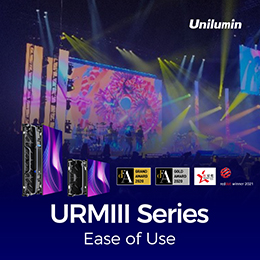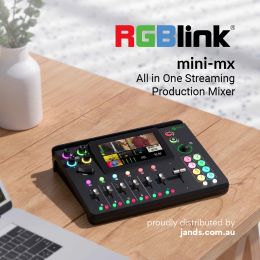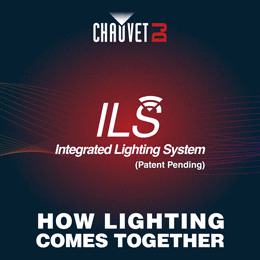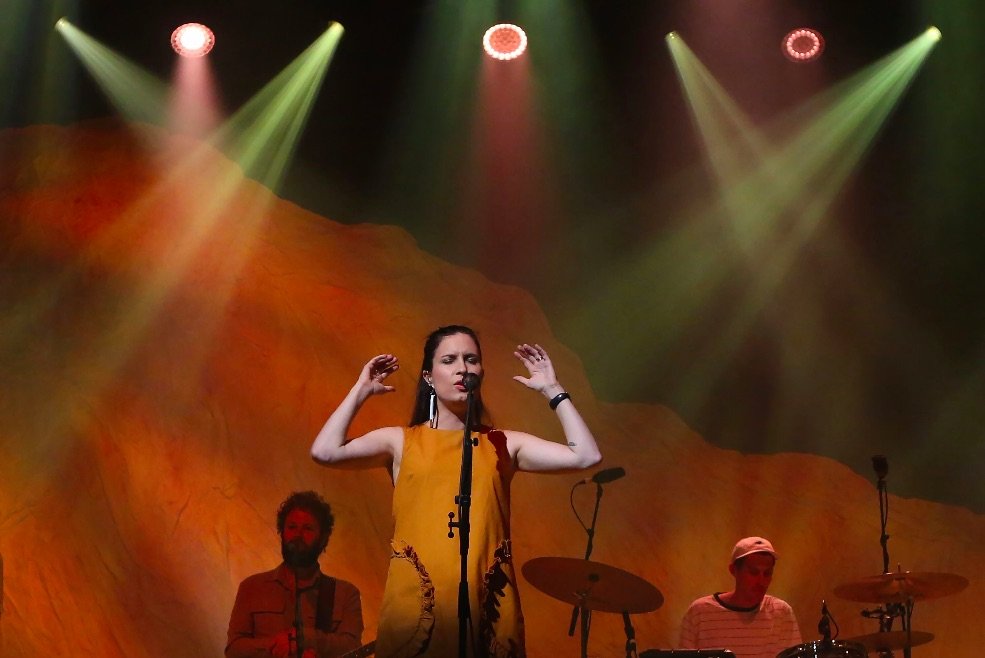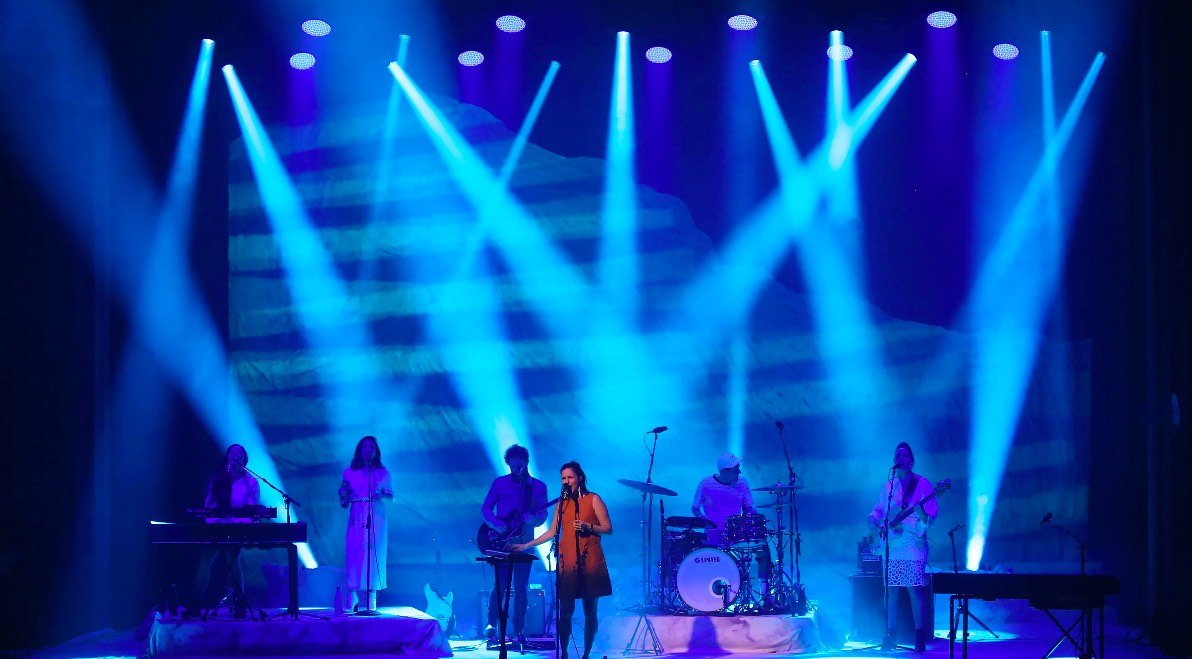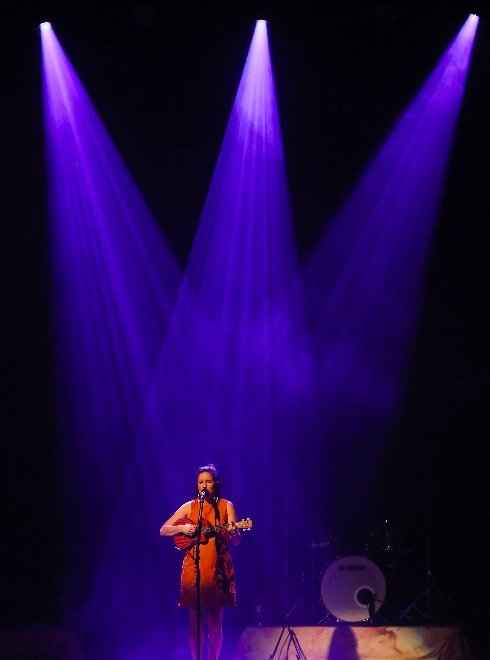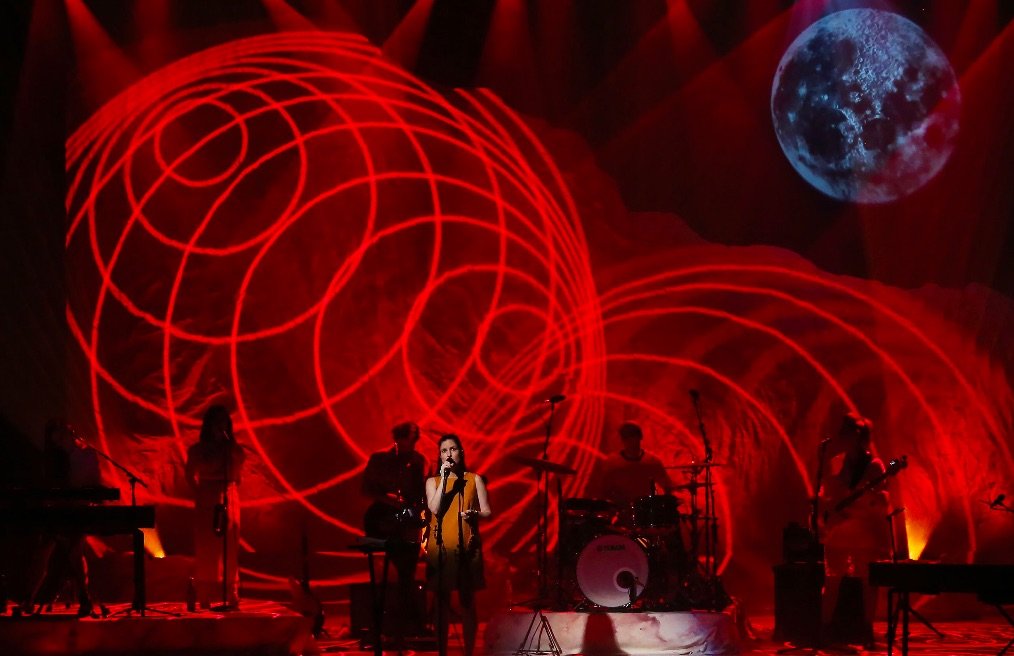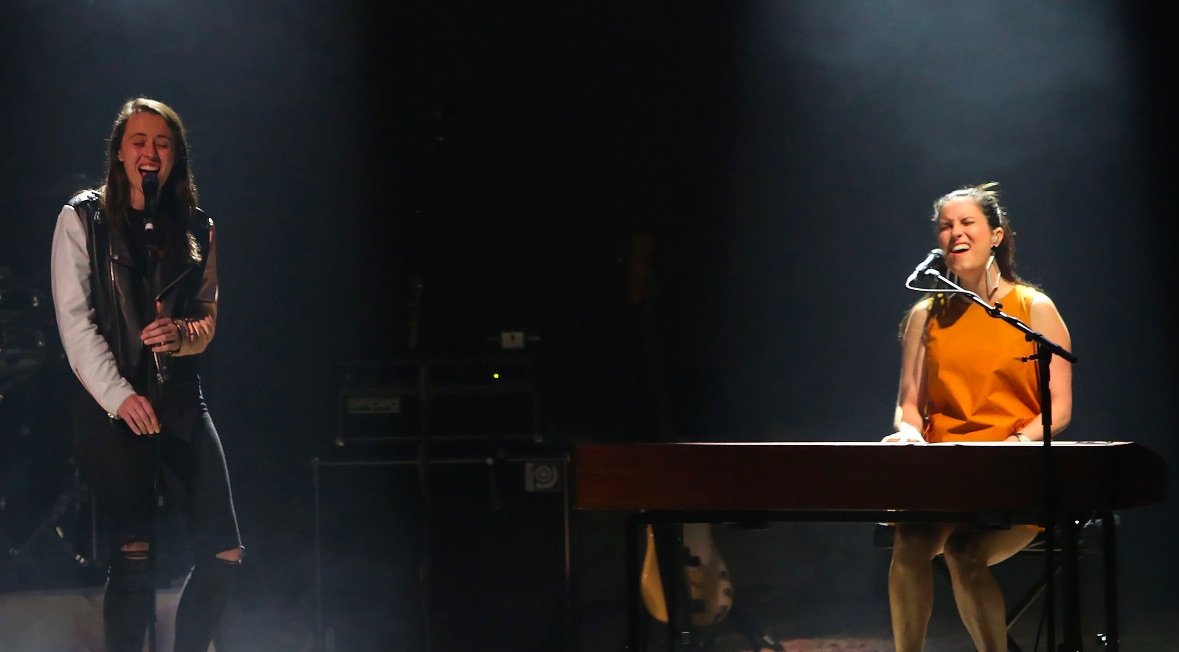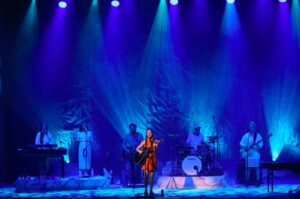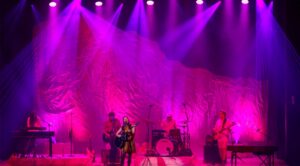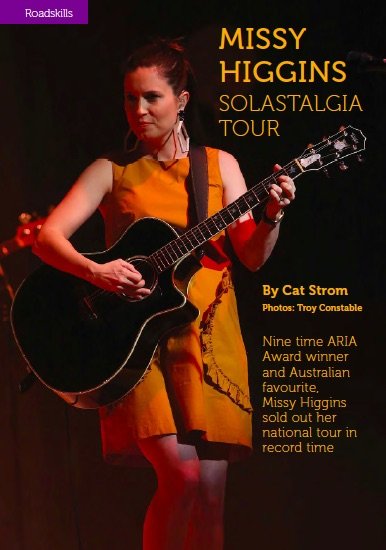Subscribe to CX E-News
Roadskills
Missy Higgins Solastalgia Tour
By Cat Strom.
Photos: Troy Constable
Nine time ARIA Award winner and Australian favourite, Missy Higgins sold out her national tour in record time.
Singer-songwriter Missy Higgins launched her long-awaited fifth studio album, Solastalgia, with an Australian tour in May. Kait Hall has been working as Missy’s lighting and set designer since 2007. As the last couple of Missy tours featured video, this time round they were keen to revisit a more tactile design resulting in four roadcases of drapes and set pieces.
The starting date for the tour was dictated in part by the Ed Sheeran shows for which Missy was the main support act. Missy is six months pregnant, so after the first round of her shows sold out quickly, they couldn’t extend the end of the tour. Instead they squeezed ten shows into thirteen days so simplicity was the key to getting things set up quickly.
“I started working on ideas for this tour last year knowing that the album had a post-apocalyptic theme running through it,” remarked Kait. “Unfortunately my ideas of what a post-apocalyptic world would look like were very different to the art direction so I had to rethink everything when I was shown the artwork. For the album cover Missy was photographed amongst very dramatic salt dunes which we have tried to emulate on stage.”
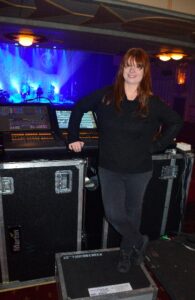
Lighting and set designer Kait Hall
Kait researched material that could give her a three dimensional, textured set piece finally deciding upon an aluminium-based molding cloth which delivered exactly the look she was seeking. Its self-supporting structure means it was perfect to mould rock shapes around the MAC Vipers on the floor, but proved too difficult to handle for the rest of the set.
“It was just too bulky and rigid to tour in large pieces. So for the backdrop we ended up using a plastic that you can heat to get ripple effects, but can fold up into a cubic box,” Kait explained. “It was then attached to a black canvas cloth. The floor is a painted canvas with lots of textured mats that are placed over cables.”
When the set is uplit or downlit, it creates textured shadows but when Kait doesn’t want a ‘salt dune’ on stage but rather a projection surface, she lights it from the front and the ripples disappear.
The set was constructed under the supervision of Sean McGrath at Reveal Productions whilst Resolution X supplied the lighting for the entire tour.
“The way ResX prep and package their gear is very reassuring,” added Kait. “It was great to have Eve Conroy on the road as systems tech who did an outstanding job. There are only two of us touring this system but Eve has been so methodical with her prep that it went up very quickly and consistently.
“I have an MA2 light with wing to run the show, it does everything I need for a structured tour and as a busking console. Like many artists, Missy might add or delete songs on the fly so you need to have an adaptable workflow. Usually we get the set list about an hour before she goes on stage so something that is quick, flexible and reliable is a must.”
A Missy show is not about lots of flashing lights, it’s about ensuring she stands out and the lights enhance that in a theatrical manner. It’s a moody environment with plenty of moments where the whole rig focuses down on Missy.
On the stage floor were four Martin MAC Vipers and eight LED Par Quads for uplighting, all buried behind layers of various set pieces so you can’t see the actual fixture. In the air, there are 14 MAC Quantum Washes and 15 MAC Vipers. Eight MAC Auras top light the set whilst eight more MAC Auras are used as key profile from the front. A solitary MAC 700 holds the moon gobo which is mentioned lyrically in a few of Missy’s songs.
“Originally I had multiple types of fixtures in the rig but when we were looking at trying to economise on truck space and fixture count – just to make it go up quickly to fit in with the schedule – I paired it back to just a few types of Martin wash and spots,” added Kait.
“The hazer is an MDG ATMe. Obviously it’s more awkward to have gas in any touring environment but it is well worth it. There’s nothing that compares to an MDG; the haze is so even and the particles are so fine plus there’s almost zero residue.”
Usually Brent Gray works as an account manager for JPJ Audio in Melbourne but whenever Missy tours, he is released from his shackles to hit the road. “At this point Missy’s schedule is just enough for me to dip my toes back in and remember what it’s like, including the parts of touring I dislike!” said Brent. “It’s been a quick, hectic tour but that’s good in a sense because you pack a lot into
a short time.
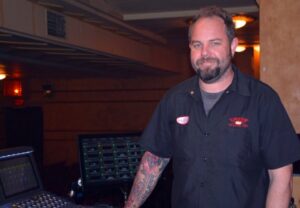
JPJ Audio’s Brent Gray
“As we’re only touring the control package we decided not to have a JPJ tech with us so it’s just Nathan Davis, monitor engineer, and myself. That means we’re setting up our own gear which keeps us busy.”
The control package included consoles, IEMs and the infrastructure to put it all together with Missy’s own mic collection. Brent ran an Avid VENUE | S6L 24d, which he describes as a considerable step up from the Avid Profile he has used for many years.
“I used a Midas XL4 on Missy’s Sound of White tour so as you can imagine I never particularly found the Profile to be an amazing sounding console,” he said. “What I did appreciate was the small footprint, especially when mixing in Australian theatres, and the workflow when compared with other similar consoles as I was experienced with Pro Tools and Mac computers.”
“In my opinion the S6L is a huge step up in sound quality as well as functionality. It sounds great, is extremely powerful and equally flexible. I really like the new programmable Layout function as well as the additional control in the Events section.
“With Missy, there’s a range of different instrumentation that is never used all at once, so instead of having to flick through layers of input and output channels to find what I need for any given song, I can have it all right there on one layout, dedicated to that particular song and recalled via the snapshot.
“Likewise, I’m now able to trigger delay sends via the x, y and colour switches on the delay return channel. For me, that level of functionality really enables creativity during the show as I spend much less time navigating the console and more time mixing.”
Brent had the new Waves option card so he could run a pair of redundant Waves servers with the S6L. The Waves plugins are installed directly onto the console meaning the settings are retained within the show file and the controls are mapped directly to the user interface. As everything bar the processing power is stored in the show file, you can run redundant servers without having to copy and paste settings between the servers.
“I use a lot of analogue emulation, pretty much the classic old school stuff such as SSL channel strips, Urei 1176, dbx 160, Pie and Fairchild compressors,” added Brent.
“The NLS Non-Linear Summer plugin is great for emulating a signal path through a discrete channel on an analogue console complete with the unique discrepancies that come with the manufacturing of individual electronic components and the various permutations that can occur within that process.
“It doesn’t do much apart from give it a signature sound, but the great thing is that they’ve modelled 32 channels of three separate consoles and every time you use it, it defaults to the next spare channel so you’re getting the emulation of not just one individual piece of analogue gear and therefore don’t get the additive artifacts from using the exact same piece of equipment.
“To me, that is one of the things that we’ve perhaps unconsciously grown to expect to hear. In the world of 0’s and 1’s I feel that we miss that.”
Brent added that in this digital world he finds himself increasingly heading back to the sound we all know and love; analogue, with its mixture of wonderful and minute imperfections, but with the power, ease and recallability of digital.
“I use the Waves plugins fairly heavily and don’t do any EQ, compression or gating on the console itself because I can build a completely custom sound console,” he said.“I started doing that on the Profile, preferring to use it more as a matrix mixer than for its sonic qualities, I’ve just continued down that path. However, with the S6L I get a very high fidelity front end which is wonderful so the analogue emulation is now more what I’d describe as recreational than medicinal, to use an analogy. Also, I can resize my custom console for an individual song which is awesome!”
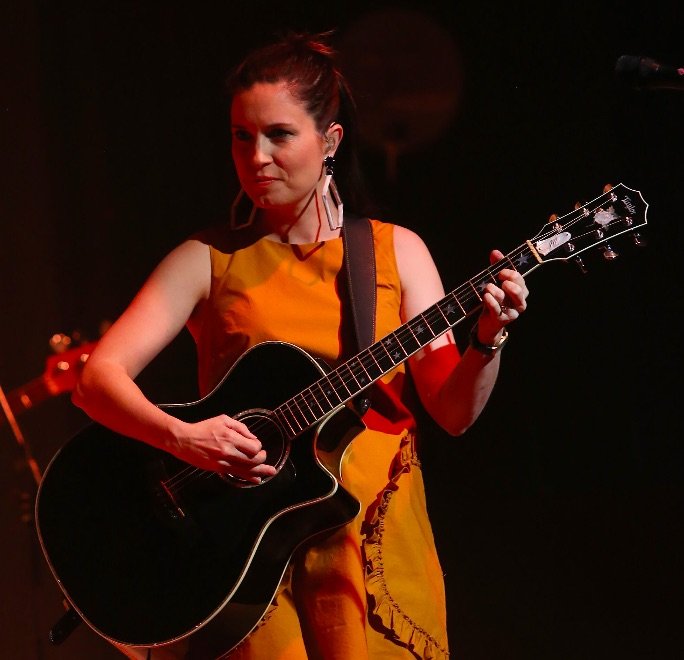 “Missy is a great singer, but her vocal tone is truly remarkable and that’s the main thing I really focus on getting across. I build up the rest of my mix around that primary element, using everything from instrumentation to equipment to help translate the emotion she is conveying lyrically and tonally in the most appropriate way I can.
“Missy is a great singer, but her vocal tone is truly remarkable and that’s the main thing I really focus on getting across. I build up the rest of my mix around that primary element, using everything from instrumentation to equipment to help translate the emotion she is conveying lyrically and tonally in the most appropriate way I can.
“I also had a couple of TC Reverb 4000s, one running an EMT 140 Plate reverb and the other a 480 Hall, both used for Missy’s vocal depending on which song. They’re great, compact units and I can run them via AES/EBU at 96k, avoiding unnecessary DA conversions and keeping everything lined up with standard S6L operation.”
The band all used Sennheiser G3 IEMS and the only stage monitoring was a couple of d&b E12 subs for the drummer. Microphones included Neumann KMS105s for Missy’s vocal mics and TLM 102s on the overheads, Shure KSM32s on guitar and bass amp, M88 on the kick and Shure 57 on snare – everything else was a Sennheiser 900 series.
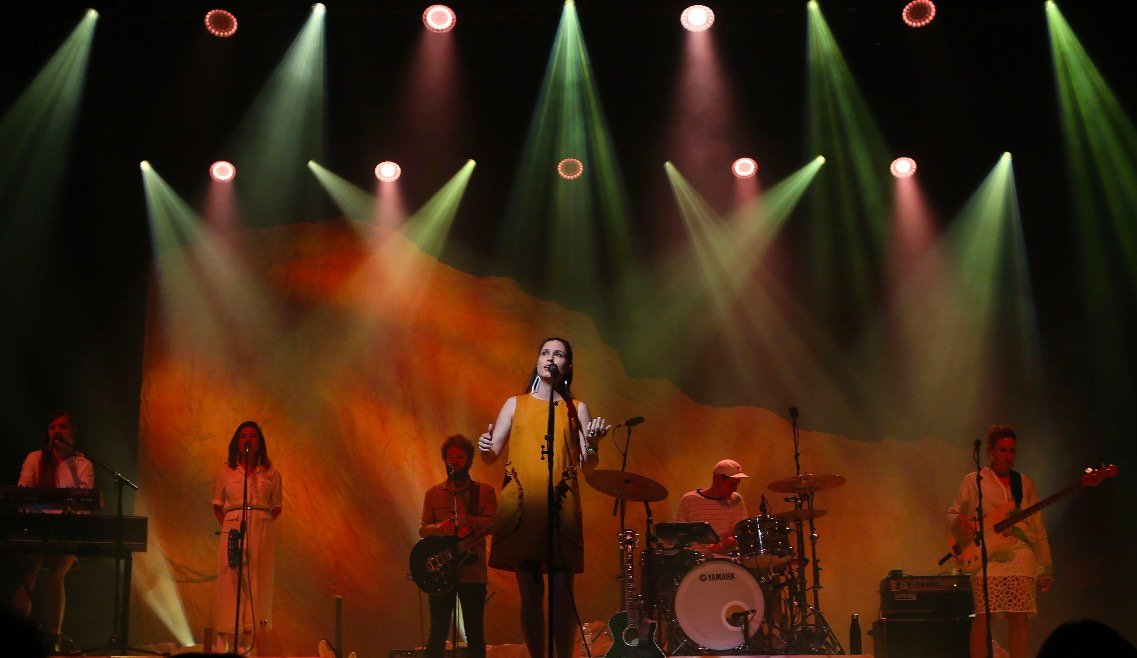
Brent finds the Enmore Theatre to be an ‘interesting’ room to mix in, observing that it can change a lot from night to night. “I don’t know if that’s because the room’s acoustics are particularly susceptible to the tonal influence of different groups of people, but I remember the first tour I did here with Missy where we did four shows in a row, every night the room sounded slightly different even though I didn’t change a thing beyond the usual balance of instruments,” he related.
“It’s the actual tone of the room but I can’t quite put my finger on what causes it. It’s quite a live room with a lot coming back through Missy’s vocal mic, but it is a Neumann KMS105 which is very open anyway. It’s probably not my favourite room to mix in but I think it sounds good!”
All tour dates were sold out and with each show finishing to a standing ovation, Missy Higgins and her crew were possibly doing a bit more than good.
This article first appeared in the print edition of CX Magazine June 2018, pp.23-25. CX Magazine is Australia and New Zealand’s only publication dedicated to entertainment technology news and issues. Read all editions for free or search our archive www.cxnetwork.com.au
All text and photos © CX Media
Subscribe
Published monthly since 1991, our famous AV industry magazine is free for download or pay for print. Subscribers also receive CX News, our free weekly email with the latest industry news and jobs.




